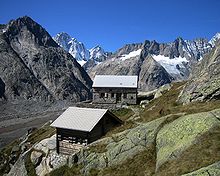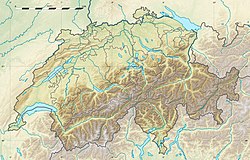Jungfrau-Aletsch protected area
| UNESCO World Heritage Site | |
|---|---|
 View of the Finsteraarhorn | |
| Location | Switzerland |
| Criteria | Natural: (vii), (viii), (ix) |
| Reference | 1037bis |
| Inscription | 2001 (25th Session) |
| Extensions | 2007 |
| Area | 82,400 ha (204,000 acres) |
| Website | www |
| Coordinates | 46°30′N 8°02′E / 46.500°N 8.033°E |
The Jungfrau-Aletsch
Geography and climate
The Jungfrau-Aletsch protected area is located in the

The culminating point is the
The summit ridge separating the cantons of Valais and Berne is the
The climate of the region is strongly influenced by the height of the mountains. They form a barrier between the wet sub-oceanic climate of the north and the drier climate of the south-facing Valais slopes. On the north side the rainfall exceeds 2,200 mm, most falling in summer, but on the south side it is only 1,000 mm, with more falling in winter. The Valais experiences a subcontinental climate at low and medium altitudes and is markedly semi-arid. Mean annual temperatures range from -8.5 °C at Jungfraujoch (3,500 m) to 9.1 °C at Brig (700 m).
Physical features

The Jungfrau-Aletsch site is almost untouched, except for trails and mountain huts. It is deeply glaciated. About half of the area is higher than 2,600 metres, a few hundred metres lower than the limit between the glaciers accumulation and ablation zones. The total area covered by glacier is 35,000 ha, it constitutes the largest continuous area of ice in the Alps. The largest and longest glacier in the Alps, the Aletsch Glacier is 23 km long and has a maximum thickness of 900 metres at Konkordiaplatz.
Area
The protected site covers an area of 82,388 ha, comprising the 53,888 ha existing World Heritage Site plus extensions at both ends totaling 28,500 ha. 56% is within the Canton of Valais, 44% within the Canton of Berne.
Flora and fauna

Glaciers and barren rock constitute 80% of the area; 6% is forested, 5.2% is alpine meadow, and 8% is scrub. Altitude is the strongest factor influencing the distribution and diversity of the vegetation. Within the nominated area there are 1,800 species of

1,250 fauna species have been recorded on the site, including 271 vertebrates: 42 mammals, 99 birds, eight reptiles, four amphibians and seven fish, and numerous invertebrates including 97 molluscs and 979 insects. As for the rest of the Alps, common species are the chamois (Rupicapra rupicapra), alpine ibex (Capra ibex), red deer (Cervus elaphus). Smaller mammals include the mountain hare (Lepus timidus), fox (Vulpes vulpes), ermine (Mustela erminea), marmot (Marmota marmota) and the reintroduced lynx (Felis lynx).
Tourism

The regions of the
History
- 1933: The protection of the Aletsch forest is assumed by the canton of Valais
- 1960: The canton of Berne assumes the protection of the upper Lauterbrunnen Valley
- 1983: The Bernese Alps are included on the Federal Inventory of Landscapes and Natural Monuments, with a revision of the area in 1998
- 2001: The area is inscribed in the UNESCO World Heritage list under the name Jungfrau-Aletsch-Bietschhorn
- 2007: Extension of the site, new name Swiss Alps Jungfrau-Aletsch
Notes and references
This article relies largely or entirely on a single source. (February 2010) |
- Swiss Alps Jungfrau-Aletsch, United Nation Environment Programme Archived 2010-08-02 at the Wayback Machine
- Swisstopo maps
- ^ Approval of site extension and management plan for Jungfrau-Aletsch-Bietschhorn World Natural Heritage, DETEC Archived 2011-06-14 at the Wayback Machine. Retrieved on 2009-10-18


